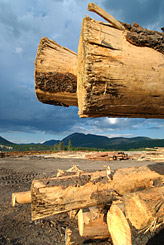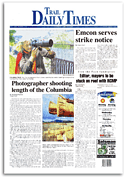
COLUMBIA TOUR: New York photographer Alison Jones (top left) is spending four weeks travelling the length of the Columbia River. She visited Trail Monday. |
 |
Photographer shooting
length of the Columbia
By Raymond Masleck, Trail Daily Times staff
(Reprinted from Trail Daily Times, Tuesday, June 19, 2007)
WHAT do the Nile and Columbia Rivers have in common besides big dams and regional dominance? Transborder issues for one: the Columbia flows through two countries, and nine African nations have a stake in the Nile.
But disagreements over water were a small part of what convinced freelance photographer Alison Jones to travel from her home in New York City to the headwaters of the Columbia, from where she is photographing her way to the Pacific Ocean. After 20 years of extended photo shoots in Africa, she is enthralled by the great rivers of the world.
“When you see that continent from the air, you realize the ribbon of life is (found on) the rivers and lake shores,” she said during a stop in Trail Monday. “My 20 years photographing Africa have all been about life on the water because once you are away from the source of water, there is no life.”
That observation gave rise to a project started in 2004, “No Water No Life,” which involves documenting and publicizing the health of rivers in Africa and North America. After the Columbia, she plans to look at the Mississippi and possibly the Colorado Rivers, as well as the lesser-known Raritan, whose headwaters are near her childhood home in northwestern New Jersey.
 |

Alison Jones’ photographic mission began at the headwaters of the Columbia in the East Kootenay’s Rocky Mountain Trench. Photo © Alison M. Jones.
|
“Water is a global issue. Perhaps Africa personifies the issue and brings it to the fore in a more dramatic way, but (watershed degradation) is an issue everywhere.”
She is too early along in her work on the Columbia to have formed any opinions, and it isn’t her intention to sift through complex issues involved in watershed ecology and make pronouncements.
So far, she has been struck by the beauty of the Canadian segment of the river and particularly the ruggedness of the mountains and forests it flows through, sometimes painfully. Hiking up the steep, boggy slopes of the Interior’s wet belt with a full pack of photography equipment has thrown her back out.
While studying the impacts of industrialization, dam construction, and global warming on the Columbia and other waterways is the job of scientists, Jones wants to use her work to spread theirs beyond academic journals and government filing cabinets.
“Scientists do years of field work and research and produce a report, and nobody really looks at it,” said Jones, who is part of a group called the International League of Conservation Photographers.
“We are trying to use the science and use the community experience and data to broaden the debate through photography.”
With the help of two ecology professors and two graduate students at Columbia University, and various foundation grants, Jones has developed a website to publicize the project, and also spreads the message through exhibitions and lectures. Other materials under consideration, depending on funding, include classroom guides and a coffee-table book.
Photos from her Columbia trip should start being posted to the website (nowater-nolife.org) in the next few days, and Jones is already planning follow-up photo shoots to the Columbia Basin.
| 

